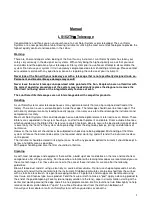
Niemals mit dem Teleskop in oder in die Nähe der Sonne blicken:
E
rblindungsgEfahr
!
8
Assembly
Listing of parts - Unpacking
It does not take long to prepare the telescope for the first observation.
When you open the package for the first time, please check the following
individually packaged parts:
Telescope:
• Equatorial mount
• Height-adjustable field tripod with clamping and fixing screws
• Optical tube, dust cap, focuser, eyepiece holder, tube clamps and locking
screws.
• 2 eyepieces (Plössl 10/25 mm)
• 2 Counterweights and counterweight rod
• 6x30 mm viewfinder
Instruction manual for assembling the telescope
The packages contain the tube and its individual parts, the tripod with the
mount and the accessories.
1. Remove the individual parts from the packaging and also familiarise your-
self with them at the same time. Use also the
images 1a to 1d
to find
your way when assembling your telescope. When you take the tripod out
of the packaging, keep it parallel to the ground, otherwise the inner legs
of the tripod will slip out as they are not yet screwed down.
2. Locking the tripod legs. Pull the legs apart as far as possible (Fig. 3).
3. Fastening of the spreader plate. To tighten the central screw (Fig. 4, E) at
the tripod, first screw the clamping nut (Fig. 4, B) all the way down, as it
serves to clamp the spreader plate against the tripod legs. Now you can
put the spreader plate (Fig. 4, C) from above on the central screw. Make
sure that the struts (Fig. 4, D) of the spreader plate point downwards (flat
surface upwards).
Attention:
It is important to perform the following step to prevent damage to the
thread.
To prevent that the threaded rod (Fig. 4, E) is screwed too far into the
mount, a spacer ring (Fig. 4, F) is included. put it from above on the
threaded rod, so that the side with the wider cut-out is facing down-
wards. The spacer ring must rest on the "shoulder" of the threaded rod.
Next, add the two washers (G). Now push the threaded rod through the
tripod head from below and slide the C-clip from above (Fig. 4a, A) on
the notch (Fig. 4a, B) of the threaded rod.
4. Attachment of the mount to the tripod head. Place the mount on the tri-
pod head (Fig. 5). Place the mount on the tripod head so that the protru-
ding cylinder on the bottom of the mount fits into the hole in the centre of
the tripod head and secure it using the center screw. Tighten the screw
hand-tight.
5. Attachment of the counterweight to the counterweight rod. Screw the base
of the counterweight rod (22, Fig. 1d) to the threaded end of the declination
axis (20, Fig. 1d). Then slide the counterweights (21, Fig. 1d) first onto the
centre of the counterweight rod (22, Fig. 1d). If you look through the large
hole in the counterweight, you will see the bolt that blocks the hole. When
you move the counterweight slightly, the bolt disappears in its hole and
releases the hole. If it does not, turn the counterweight clamping screw
(21a, Fig. 1d) carefully until the bolt moves. Remove the counterweight lock
(23, Fig. 1d) off the rod. Then, while holding the counterweight firmly, push
it to about the middle of the counterweight rod (22, Fig. 1d). Tighten the
counterweight locking screw securely and replace the locking screw.
NOTE:
Should the counterweight ever start to slip, the locking screw prevents it
from slipping completely off the rod. Always leave the locking screw in place
as long as there is a counterweight on the rod.
6. Setting the latitude: It is easier to adjust the latitude before you attach
the weights and put the tube on the mount. Locate the latitude scale (28,
Fig. 3: the tripod
Fig. 4 Fastening of spreader plate
and spacer ring
Fig. 4a: Securing the threaded rod
by means of a C-clip
A
B
Fig. 5: Mounting the mount on the
tripod
Azimuthal
fine adjust-
ment
ASSEMBLY
E
E
F
G
F
G
B
A
C
D






































